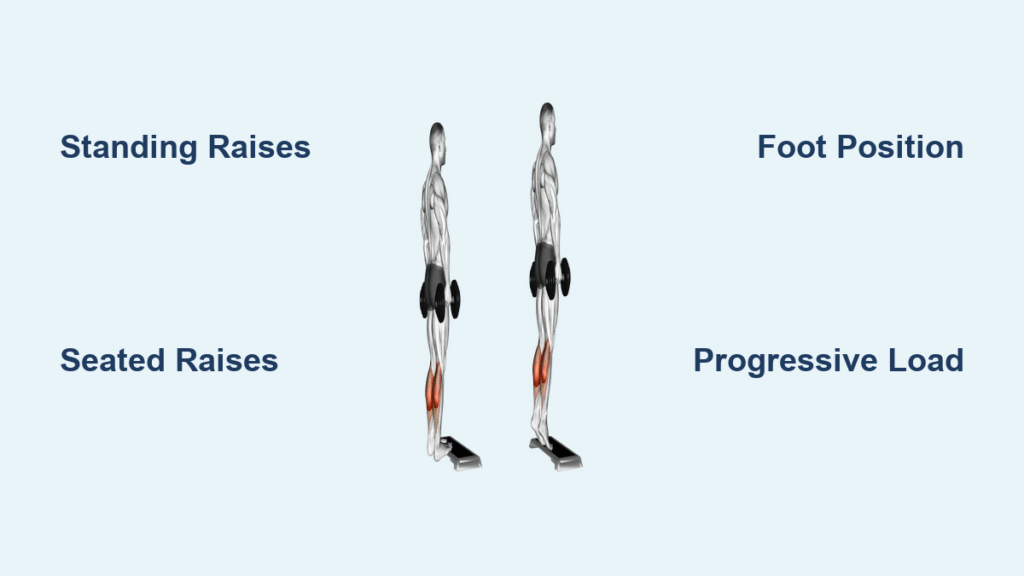Your calves stubbornly resist growth despite endless bodyweight raises. That frustrating plateau happens because these muscles demand strategic dumbbell loading to overcome their natural endurance capacity. This guide delivers the exact protocols backed by muscle physiology that transform skinny lower legs into powerful, defined calves—no gym membership required. You’ll discover how to leverage simple dumbbells to trigger growth in both the gastrocnemius and soleus, the two distinct muscles that create complete calf development.
Why Your Calves Refuse to Grow Without Dumbbells
Most calf training fails because it ignores critical anatomy. Your lower leg contains two primary muscles requiring different approaches: the gastrocnemius (the visible diamond-shaped muscle) packed with fast-twitch fibers for explosive power, and the deeper soleus loaded with slow-twitch endurance fibers. Bodyweight exercises only challenge these muscles through limited ranges of motion, failing to create the progressive overload essential for growth. Dumbbells solve this by providing adjustable resistance that forces both muscle groups to adapt beyond their current capacity.
Without sufficient loading, you’re merely maintaining—not building—muscle. The soleus particularly demands heavy resistance since it handles 90% of your bodyweight during walking. Strategic dumbbell loading creates the mechanical tension and metabolic stress needed to break through genetic limitations and finally build those coveted calf peaks.
Standing Dumbbell Calf Raises: Hit the Gastrocnemius Peak

This foundational exercise targets the showy gastrocnemius muscle when performed with straight legs. Stand on an elevated surface like stairs or stacked weight plates, holding heavy dumbbells at your sides. Position your feet shoulder-width apart with balls of feet firmly on the edge and heels hanging freely. Rise onto your toes with explosive power, driving through the big toe and pinky toe equally to engage both calf heads. Hold the peak contraction for 1-2 seconds while squeezing hard before lowering slowly over 3 seconds until you feel a deep stretch in your Achilles tendon.
Avoid this critical mistake: Rolling your ankles inward or outward. Keep pressure evenly distributed across the entire ball of your foot. If you wobble, lightly touch a wall for balance—but never use momentum to bounce through the movement. Start with 3 sets of 12-15 reps using a weight that challenges you on the final reps, increasing the dumbbell weight by 5-10% once you hit the top of your rep range.
Single-Leg Standing Variations for Complete Development
Performing single-leg raises corrects strength imbalances while increasing range of motion. Stand on one foot on your elevated surface, holding a dumbbell in the opposite hand for counterbalance. Execute 8-10 controlled reps per leg, focusing on a full stretch at the bottom. When this becomes manageable, hold a dumbbell in both hands for added resistance. This unilateral approach reveals weak points that bilateral training hides, forcing each calf to work independently for symmetrical growth.
Seated Dumbbell Calf Raises: Unlock Soleus Thickness
While standing raises target the gastrocnemius, seated variations specifically hammer the soleus—the deeper muscle responsible for overall calf thickness. Sit on a bench with knees bent at 90 degrees, placing dumbbells across your thighs (a single heavy dumbbell works for both legs). Rest the balls of your feet on weight plates, books, or a step. Press through your toes to lift your heels maximally, holding the peak contraction for 1 second before lowering slowly into a deep stretch.
Pro tip: The soleus can handle heavier loads than you think. Most lifters use 20-30% more weight seated than standing due to the muscle’s endurance capacity. Start with 4 sets of 15-20 reps using challenging weight, emphasizing the 3-second eccentric descent. Never skip this exercise—neglecting soleus development creates “flat” calves that lack 3D fullness from all angles.
Foot Position Secrets for Complete Calf Development

Your foot angle dramatically shifts muscle emphasis during every rep. Rotate through these positions weekly to build balanced, aesthetic calves:
- Toes straight ahead: Creates even gastrocnemius development
- Toes turned inward 15 degrees: Targets the outer (lateral) head for width
- Toes turned outward 15 degrees: Emphasizes the inner (medial) head for thickness
Perform each variation for one full week before rotating. For example, if you train calves twice weekly, use straight toes on Monday and inward angle on Thursday. This systematic rotation ensures no part of your calf goes underdeveloped—a common flaw in “stuck” calf growth. Avoid extreme angles beyond 15 degrees as they strain ankle ligaments.
Triple Threat Finisher for Stubborn Growth
When standard sets stop working, deploy this metabolic annihilator that recruits every available fiber. Immediately after your main workout, blast through this sequence with minimal rest:
- 10 standing calf raises (heavy dumbbells)
- 10 seated calf raises (moderate weight)
- 10 single-leg bodyweight raises (each leg)
Complete all three exercises back-to-back without rest for one round, then rest 60 seconds and repeat. The standing raises exhaust the gastrocnemius, seated work smashes the soleus, and single-leg bodyweight raises create a crushing burn that triggers growth hormones. Limit this protocol to 2 rounds once weekly—your calves will need serious recovery time.
Home Gym Hacks for Effective Loading
No calf block? No problem. Stack thick books under your toes for elevation, or use a sturdy stair step. Place a heavy backpack filled with books or water bottles across your thighs for seated raises when dumbbells are unavailable. For standing raises, hold gallon water jugs if dumbbells are too light—each gallon adds 8.3 pounds of resistance.
Progression hack: When bodyweight becomes easy, stand on a single step with heels dropping below stair level for a deeper stretch. This increases range of motion by 30-40%, creating greater muscle damage. Add resistance gradually—never jump more than 10% in weight weekly to avoid Achilles strain.
Weekly Dumbbell Calf Program Blueprint
Don’t train calves like other muscles. Their high endurance capacity requires unique programming:
- Beginners (Weeks 1-4): Train twice weekly. Monday: Standing raises 3×15. Friday: Seated raises 3×20. Use moderate weight focusing on perfect form.
- Intermediate (Weeks 5-8): Train three times weekly. Monday: Heavy standing (5×8). Wednesday: Volume seated (4×15). Friday: Standing single-leg (3×10 per leg).
- Advanced (Weeks 9-12): Train four times weekly. Split focus: Monday/Thursday hit gastrocnemius with standing variations; Wednesday/Saturday target soleus with seated work.
Always train calves after compound leg exercises like squats or deadlifts when your nervous system is fresh. Never skip warm-ups—5 minutes of light cardio followed by ankle circles prevents injury during heavy loading.
Fix These 3 Calves-Blocking Technique Errors
Error #1: Incomplete Range of Motion
Most lifters perform partial reps, stopping short of a full stretch. Fix: Lower until you feel a deep pull in your Achilles tendon. If your heel won’t drop below platform level, elevate your toes higher using thicker books or stacked plates.
Error #2: Bouncing Through the Stretch
Using momentum reduces time under tension. Fix: Implement a strict 3-second lowering phase. Count “one-thousand-one” as you descend to maximize muscle damage.
Error #3: Locked Knees During Standing Raises
Hyperextending knees shifts stress to joints. Fix: Maintain a 5-degree knee bend throughout standing variations to protect joints while maximizing gastrocnemius engagement.
When Calves Still Won’t Grow: Troubleshooting Guide
If progress stalls after 4 weeks, implement these science-backed fixes:
- Increase weekly volume to 15-20 total sets across 3 sessions. Calves tolerate more volume than any muscle group.
- Add eccentric overload: Lower with 20% heavier weight than you can lift, using both legs to raise and one leg to lower.
- Check loading: Most people train too light. If you complete all reps without burning failure, increase weight immediately.
For persistent Achilles discomfort, switch to seated raises for 2 weeks while performing eccentric heel drops: Stand on a step, lift with both feet, then lower slowly on one foot over 5 seconds. This strengthens tendons without aggravating pain.
Post-Workout Recovery Protocol
Calves recover faster than quads or hamstrings but still need strategic recovery. Within 60 minutes post-workout, consume 25-30g protein with carbohydrates to replenish glycogen. Perform 45-second static stretches targeting both straight-leg (gastrocnemius) and bent-knee (soleus) positions. Foam roll calves for 60 seconds daily to improve blood flow—spend extra time on tender spots near the Achilles insertion.
Critical warning: If soreness lasts beyond 72 hours or you experience sharp Achilles pain, reduce volume immediately. Overtraining calves creates long-term tendon issues that halt progress for months.
Your path to powerful, defined calves starts today—no more excuses. Load those dumbbells, execute every rep with perfect form, and watch your lower legs transform within 8 weeks. The missing piece wasn’t genetics; it was strategic dumbbell loading. Now go make your calves impossible to ignore.




